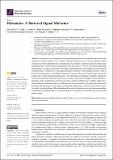Por favor, use este identificador para citar o enlazar a este item:
http://hdl.handle.net/10261/255797COMPARTIR / EXPORTAR:
 SHARE
BASE SHARE
BASE
|
|
| Visualizar otros formatos: MARC | Dublin Core | RDF | ORE | MODS | METS | DIDL | DATACITE | |

| Título: | Histamine: A bacterial signal molecule |
Autor: | Krell, Tino CSIC ORCID; Gavira Gallardo, J. A. CSIC ORCID ; Velando, Félix CSIC ORCID; Fernández, M.; Roca, Amalia CSIC ORCID; Monteagudo-Cascales, Elizabet CSIC ORCID; Matilla, Miguel A. CSIC ORCID | Palabras clave: | Histamine Signal molecule Sensing Pseudomonas aeruginosa Histamine receptors Chemotaxis Gut microbiome |
Fecha de publicación: | 2021 | Editor: | Multidisciplinary Digital Publishing Institute | Citación: | International Journal of Molecular Sciences 22(12): 6312 (2021) | Resumen: | Bacteria have evolved sophisticated signaling mechanisms to coordinate interactions with organisms of other domains, such as plants, animals and human hosts. Several important signal molecules have been identified that are synthesized by members of different domains and that play important roles in inter-domain communication. In this article, we review recent data supporting that histamine is a signal molecule that may play an important role in inter-domain and inter-species communication. Histamine is a key signal molecule in humans, with multiple functions, such as being a neurotransmitter or modulator of immune responses. More recent studies have shown that bacteria have evolved different mechanisms to sense histamine or histamine metabolites. Histamine sensing in the human pathogen Pseudomonas aeruginosa was found to trigger chemoattraction to histamine and to regulate the expression of many virulence-related genes. Further studies have shown that many bacteria are able to synthesize and secrete histamine. The release of histamine by bacteria in the human gut was found to modulate the host immune responses and, at higher doses, to result in host pathologies. The elucidation of the role of histamine as an inter-domain signaling molecule is an emerging field of research and future investigation is required to assess its potential general nature. | Versión del editor: | http://dx.doi.org/10.3390/ijms22126312 | URI: | http://hdl.handle.net/10261/255797 | DOI: | 10.3390/ijms22126312 | Identificadores: | doi: 10.3390/ijms22126312 issn: 1422-0067 |
| Aparece en las colecciones: | (EEZ) Artículos |
Ficheros en este ítem:
| Fichero | Descripción | Tamaño | Formato | |
|---|---|---|---|---|
| 2021_Krell_IJMS_OA.pdf | 1,52 MB | Adobe PDF |  Visualizar/Abrir |
CORE Recommender
PubMed Central
Citations
6
checked on 23-abr-2024
SCOPUSTM
Citations
6
checked on 24-may-2023
WEB OF SCIENCETM
Citations
6
checked on 26-mar-2023
Page view(s)
44
checked on 26-abr-2024
Download(s)
214
checked on 26-abr-2024

